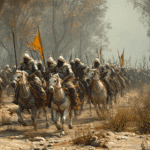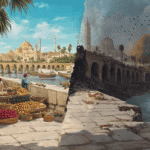
The Hindu Mataram Kingdom, centered on the fertile plains of central Java , stands as one of classical Southeast Asia’s most emblematic dynasties. Between the 8th and 10th centuries, this empire carved a unique space in history, before its sudden decline.
Roots of Mataram
The Mataram Kingdom first emerged around the mid-8th century in central Java (in modern day Indonesia) along the fertile basin near the Progo and Opak rivers. Earlier, small Hindu-Buddhist polities had already flourished in Java due to Indian cultural and commercial influence. Traders from South India, particularly from Tamilakam and the Pallava sphere, brought with them Brahmanical rituals and Sanskrit literacy, both of which were woven into native cults and political language.
By the time of Sanjaya, the kingdom’s first widely acknowledged monarch (r. c. 732 CE), Java had begun developing its classic Indianized polity. The inscription he left – the Canggal Inscription of 732 – proclaims him the establisher of a lingam of Shiva on Gunung Wukir, linking royal legitimacy with Hindu cosmology. This act signaled the beginnings of a highly distinctive Javanese Hindu state that sought to define kingship as a bridge between divine power and earthly prosperity.
Political Structure and Dynastic Duality
From its early period, Mataram was not a simple monarchy but a layered, decentralized kingdom drawing on both Indic and Austronesian traditions. Kingship was sacral, portraying the ruler as a protector whose well-being was tied to the fertility of the land and crops. Religious legitimation was essential: kings were often deified as manifestations of Shiva, Vishnu, or other Hindu deities after death.
Interestingly, the Mataram Kingdom showcased dynastic duality. Two major families alternated dominance:
- The Sanjaya dynasty, originally Hindu Shaivite, beginning with Sanjaya himself.
- The Shailendra dynasty, which rose shortly thereafter and patronized Mahayana Buddhism.
Rather than constant infighting, there seems to have been moments of cooperation, intermarriage, and joint religious sponsorship. This dual authority gave rise to some of Java’s most astonishing monuments, as both dynasties competed – and collaborated – in building sacred architecture.
The Golden Age: Monuments in Stone
The golden age of the Mataram Kingdom, spanning roughly the 8th to 9th centuries, is primarily remembered for monumental temple building. This burst of creativity transformed central Java into one of the most sacred landscapes in Asia.
- Borobudur Temple (early 9th century): Built under the Shailendra dynasty, Borobudur is the largest Buddhist monument in the world. Shaped like a mandala and cosmic mountain, its nine stacked terraces contain over 2,600 reliefs and 500 Buddha statues. It represents not only spiritual devotion but the mastery of Javanese architects and stonemasons.
- Prambanan Temple Complex (mid-9th century): Not far from Borobudur, the Sanjaya kings sponsored the construction of Prambanan, dedicated to Shiva. Rising to 47 meters, its central tower soars over the plain, flanked by temples to Vishnu and Brahma. The Ramayana reliefs carved along its galleries illustrate how Indian epics were woven into Javanese cultural identity.
- Smaller sanctuaries like Sewu, Kalasan, and Plaosan temples testify to a rich coexistence of Hindu and Buddhist devotion.

This monumental age was underpinned by agricultural wealth. The Progo and Opak river basins were fertile rice-producing lands, and inscriptions reveal sophisticated irrigation systems controlled under royal supervision. The prosperity generated from rice surpluses financed temple construction, supported a growing priestly and artisan class, and integrated local communities into the kingdom’s sacred geography.
Cultural and Intellectual Life
The Mataram Kingdom absorbed Indian concepts but reorganized them through Javanese lenses.
- Language and Literature: Sanskrit inscriptions dominated royal proclamations, yet Old Javanese was emerging as a literary medium. This bilingualism anchored both cosmopolitan and local identities.
- Religion: Far from rigid sectarianism, Hindu Shaivism and Mahayana Buddhism existed side by side. Joint dedications suggest a fluid spiritual environment fostering eclectic worship.
- Art and Theatre: Relief carvings on temples became a canvas for narrative art. Scenes from the Jataka stories, Mahabharata, and Ramayana were depicted, shaping performance traditions like wayang (shadow puppetry) that persist in Indonesia today.
This combination of spirituality, artistry, and agricultural affluence is what qualifies this period as Mataram’s golden age.
Expansion and Regional Influence
The power of Mataram extended beyond central Java. By the 9th century, through naval trade links and naval expeditions, the kingdom projected influence across the Indonesian archipelago.
- The Nalanda inscription in Bengal records the Shailendra king Balaputradeva’s patronage of a monastery in India. This illustrates both wealth and the international prestige of Java’s rulers.
- Control of coastal ports allowed Mataram to participate in the lucrative Indian Ocean trade linking China and India. Spices, rice, and forest products moved outward, while silk, ceramics, and cultural ideas entered Java.
Despite being a largely agrarian inland kingdom, Mataram demonstrated acute awareness of maritime power, though it remained weaker at sea compared to future Javanese states like Majapahit.

Seeds of Decline
By the late 9th century, underlying stresses began to erode Mataram’s strength.
- Geographical Constraints: Central Java was agriculturally rich but vulnerable to natural disasters. Volcanic eruptions from Mount Merapi and earthquakes periodically devastated settlements and temples. Some historians suggest a catastrophic eruption directly contributed to the sudden relocation of power.
- Political Rivalries: The dynastic duality between Sanjaya and Shailendra may have fostered instability. After periods of coexistence, shifting alliances and succession disputes weakened unity.
- Shifting Trade Routes: By the late 9th and early 10th century, Javanese coastal centers like those along the north coast of Java began to eclipse inland agrarian courts as trade hubs. This undermined Mataram’s inland capital in the Kedu and Kewu plains.
The Sudden Move to East Java
The most dramatic sign of Mataram’s decline was its sudden relocation eastward. In the early 10th century, King Mpu Sindok abandoned central Java and established a new seat of power around the Brantas River valley in East Java. The reasons remain debated.
- Volcanic Disaster Hypothesis: Some hypotheses suggest a large eruption of Mount Merapi rendered central Java inhospitable, devastating farmland and temples.
- Strategic Trade Hypothesis: Moving closer to the Brantas valley and the coast gave the kingdom better access to maritime trade routes.
- Political Pressure Hypothesis: Coastal polities or Sumatran powers like the Srivijaya Empire may have exerted pressure that made relocation necessary.
Whatever the cause, this eastward shift marked the end of the golden age centered in central Java. Though Mataram retained political continuity in its new homeland, the artistic and architectural brilliance of the 8th-9th century was never matched again.

Legacy of the Golden Age
Even though the Hindu Mataram Kingdom declined suddenly, its legacy endured in profound ways:
- Temples: Borobudur and Prambanan remain UNESCO World Heritage Sites and are central symbols of Javanese cultural identity.
- Religion: Hindu-Buddhist syncretism laid the groundwork for later Javanese cosmology, influencing Majapahit and surviving even into Islamic Javanese traditions.
- Art and Literature: Ramayana performances, shadow puppetry, and Old Javanese epics (like the Kakawin poems) draw direct lineage to this period.
The sudden decline of Mataram also became a cultural metaphor in Javanese chronicles: even the greatest kingdoms are subject to the cycles of rise and fall, fortune and disaster.
Conclusion
The Hindu Mataram Kingdom’s golden age was brief yet brilliant. From Sanjaya’s foundations to the monumental synergy of Sanjaya and Shailendra legacies, central Java became a sacred and political heartland of Southeast Asia. For a century and more, rice wealth, religious ambition, and artistic genius converged to produce Borobudur, Prambanan, and countless other works whose scale astonishes the modern world.
Yet this greatness was fragile. Geographical vulnerability, dynastic rivalries, and shifting trade routes abruptly shifted the kingdom to East Java, leaving behind a haunting silence among the once-prosperous temples. Like Mount Merapi looming in the background, Mataram’s fate reminded Javanese society of the impermanence of power. Even in decline, however, Mataram achieved immortality. Its golden age became a civilizational touchstone, shaping the trajectory of Javanese culture well into the age of Majapahit and beyond.




